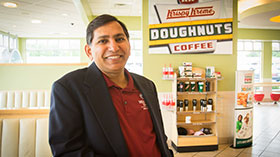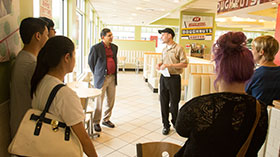Logos, layouts and logistics: Franchising in today’s market
 “Most people think of franchising as an industry, but the fact is that franchising is actually not an industry; it is a business model,” said Garg. “Franchising is everywhere. It’s in education, hospitals, aviation training and even interior decoration.”
“Most people think of franchising as an industry, but the fact is that franchising is actually not an industry; it is a business model,” said Garg. “Franchising is everywhere. It’s in education, hospitals, aviation training and even interior decoration.”
Over the years, Garg conducted most of his research in franchising, particularly multi-unit franchising, by surveying more than 100 franchises in various fields. The results provided Garg with enough information to create statistical models that explain the success of multi-unit franchising. But surveying comes with its own challenges, so he also employs triangulation.
“Franchising is everywhere.” — Dr. Vinay Garg
“Essentially, triangulation is the use of various methods to come to a similar result to ensure a one-time result is not generalized across different populations and settings,” says Garg. “For example, a respondent may say only good things in order to be looked favorably upon or avoid pulling down their image or that of the company. By using published records in combination with survey data and interviews, we are provided with a more accurate picture.”
Garg has had his research published more than 20 times since 2000, a testament to his dedication and findings concerning franchising.
The basic business model
So what is franchising? When an entrepreneur is looking to start their own small business, they have the option to buy a franchise. With a franchise, the franchisee will follow established procedures that have previously been proven successful and pay regular royalties to the franchisor.
“Instead of the franchisor having a 500-restaurant chain, they can make 5,000 or 10,000 in the same time because they don’t have to invest their own money or task their managers with the job of building one restaurant at a time,” said Garg. “McDonald’s has over 36,000 franchises in 100 plus countries. More than 80 percent of McDonald’s restaurants worldwide are franchised. Each day a new franchisee is building a store somewhere in the world, but McDonald’s is free from having to invest and worrying about the nuts and bolts of creating and operating it.”
 Franchises can be a great opportunity for entrepreneurs looking to start their own business without the hassle (or struggle) of the trial-and-error that comes with starting a business from scratch. In addition, franchises benefit from the name recognition that comes with a well-established brand.
Franchises can be a great opportunity for entrepreneurs looking to start their own business without the hassle (or struggle) of the trial-and-error that comes with starting a business from scratch. In addition, franchises benefit from the name recognition that comes with a well-established brand.
There are some drawbacks, though. Franchising doesn’t allow much, if any, creative freedom, and franchisees often feel undue pressure to offer deals that can reduce their profit margins. Franchisees are also required to enter into a contract that includes strict guidelines for things like marketing and operations.
“Let’s say a person who owns a McDonald’s starts selling cakes or cookies at their store and the quality is poor,” said Garg. “Then McDonald’s pays the penalty. Although it had nothing to do with McDonald’s typical menu items, its brand gets tarnished. So, strict contracts allow franchisors to avoid these sorts of issues and control the behavior of franchisees.”
The future of franchising
Though Garg has examined many issues over his years researching franchising, this is only the tip of the iceberg. Garg is delving into research about new forms of franchising, such as store-within-a-store (a Subway within a Patriot gas station) or a small food court comprised of many brands (such as Taco-Bell, KFC and Pizza Hut) owned by the same corporation (Yum Brands) within one location.
“It will be interesting to discover what the challenges are in new approaches to the franchising business model,” he added.

